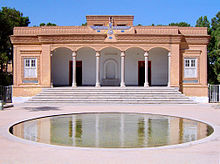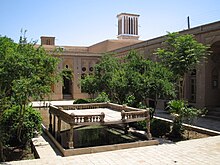Yazd (province)
| استان یزد Yazd
|
|
|---|---|
| Location of the Yazd Province in Iran | |
| Basic data | |
| Country | Iran |
| Capital | Yazd |
| surface | 129,285 km² |
| Residents | 1,138,533 (2016 census) |
| density | 8.8 inhabitants per km² |
| ISO 3166-2 | IR-25 |
Coordinates: 31 ° 53 ' N , 54 ° 40' E
Yazd ( Persian استان یزد, DMG Ostān-e Yazd ) is one of the 31 Iranian provinces. The capital is the city of the same name, Yazd .
1,138,533 people live in the province (2016 census). The area of the province extends to 129,285 square kilometers. The population density is 8 people per square kilometer.
geography
The province is in the center of the country. Major cities are Yazd , Mehriz , Meybod , Taft , Ardakan and Bafgh . The pomegranates grown in the province are well known .
population
The population of Yazd is composed almost entirely of Persians , most of them Shiite Muslims. However, a relatively large number of Zoroastrians still live in Yazd. There are still some fire temples ( Persian آتشكده, DMG Ātaškade ) the Zoroastrians.
Administrative division
The Yazd Province is divided into eight counties:
history

In 1272 the Venetian merchant Marco Polo traveled to the area of today's province, which was then under the rule of the Atabegs of Yazd .
Yazd became historically significant in 1907 when the border and apex of the Anglo-Russian spheres of interest in Persia were contractually established. The Russian influence was to dominate north of a line from Yazd, northwest to Kurdistan and from Yazd northeast to the Persian- Afghan- Russian triangle (today: Iranian-Afghan- Turkmen triangle), south of it the British.
Attractions
- Fire temple in Yazd
- Town houses in Yazd
- Wind tower (Badgir) for air cooling in the old town of Yazd
- Zoroastrian "Tower of Silence" ( Dachma ) on the outskirts of Yazd
- Yazd Friday Mosque
- Mosque and Takiyya of the Emir Tschaqmaq
- Cemetery of Iranian soldiers who died in the Iran-Iraq war in Yazd
- Pigeon house in Meybod
- Citadel in Maybod
- Mausoleum of Sayyid Rukn ad-Din in Yazd
- Kurit dam near Tabas
- Abarkuh cypress
Economy and Infrastructure
The Saghand Mine contains an estimated 1,000 tons of uranium; however, the ore has an uneconomically low uranium concentration. The factory in Ardakan enriches it with yellow cake .
Colleges
- University of Yazd
- Shahid Sadoughi University of Medical Sciences and Health Services
- Islamic Azad University of Bafgh
- Islamic Azad University of Mehreez
- Islamic Azad University of Yazd
- Yazd Sampad Information Center
Sons and Daughters of the Province
- Mohammad Chātami (* 1943), Iranian President
- Moshe Katzav (* 1945), Israeli President
Web links
Individual evidence
- ↑ City Population: Iran - Cities and Provinces .
- ↑ http://www.isisnucleariran.org/sites/detail/uranium-mining/




